Grant Morrison’s run on Action Comics has been met with both high praise and no small measure of bewilderment. But this is a legendary run – you just need to think five dimensionally.
When Morrison was announced as the writer of Action Comics #1, back in 2011, there was a great deal of excitement within the comics community. The man who had given us one of the greatest Superman books of all time, All-Star Superman, seemed a poetic choice as the architect of this brand new history. Morrison spoke of his love for the original Golden Age character, his socialist roots and desire to do good in the world; Superman as a folk tale, before he became the centrepiece of our modern mythology. The young Kal, standing proud and over-confident in his American jeans and self-branded t-shirt, cape flying behind him as he raced from one adventure to the next.
Action Comics, set five years behind the current day Superman comic, was to show us how Kal went from farmboy to international hero – from brash young man to a wiser one – but also to introduce all the pieces of the puzzle that make him who he is. There was fan outcry at the pre-publication revelations that Clark and Lois would no longer be a couple, and that Clark’s parents would no longer be alive. Comic fans, strangely adverse to change in a constantly recycling continuity, were outraged at the lack of a romantic plot with Lois, perhaps inadvertently recasting her in their minds as in existence only to please the leading man. The lack of parents of course linked this Superman much more strongly to his Golden Age roots, and removed him too from any existing connections to the world he found himself living on. An alien alone.
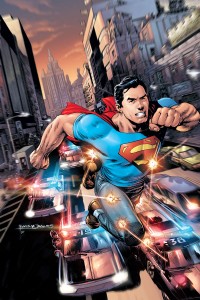
Unsurprisingly, many readers were somewhat lost at various points – because when I say fragmented, I am being quite literal. After only four issues it was necessary for artist Rags Morales to need a break to catch up, and another plot was inserted with both the baby Kal’s escape from Krypton, and a future Superman returning to a point in time not long after the previous issue. The change in art style thanks to Andy Kubert for this two issue interlude helped underscore the time difference, and in issue seven we were back on our original track. These interludes became a signature of Morrison’s run, with further adventures spending time on the Superman of Earth 23 – and a meta teaser for Morrison’s upcoming Multiversity – as well as a Halloween trip to the Phantom Zone, and of course the obligatory issue zero with its genuinely heartwarming tale.
But here’s the thing: Morrison planned a short six issue run on the comic. When the first artist change came up, he told me that:
“…for me it hits the long term collections of it to have things done like that but at the same time it brings back a lot of the freshness and improvisation of doing comics again and just responding to that and also sometimes you know they’ll be like we need a two part filler here – okay I’ll just come up with something, and it might not necessarily fit it in to the middle of this but okay, you need a filler.”
And yet, every little aspect of this comic – from the future plot to the Phantom Zone to the appearance of the little teetotal man in the first panel of issue one – suggests a much grander plan. If I was uncharitable I’d chalk this up to a mild case of fibbing, but I know that’s not the case. Of course it’s likely that someone with so much knowledge of the DC universe would subconsciously drop little things in to the narrative that might turn out to be useful later – but for a six issue run? It’s a marvellous little contradiction that is completely in keeping with the unfolding story itself, perhaps demanding that it be told.
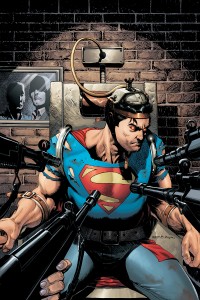
This alone woud be a solid little arc, establishing Kal as an accepted hero, uniting him with Brainiac and his Fortress of Solitude, placing Lex, Lois and Jimmy on our radar of people to look out for, and… well, also hinting at the involvement of the 5th dimension, casually mentioning a missed visit that is later revealed to be the Legion of Superheroes, foreshadowing the appearance (and constant invisible presence) of Krypto, a suggestion that the small man is the devil, and the introduction of Nimrod who we know will shoot Superman in the brain in the future because we’ve seen it in a past issue, as well as the K-Men who don’t actually quite exist yet because they’re from the future also, and the future form of Eric Drekken and the existence of the “First Superman”.
All in all, it’s a good job Morrison stayed on to write more as while those plot bunnies would have given any writer much to play with, it’s clear that by now there was a greater plan in mind. In the first 8 issues, the fragments were already starting to tug apart, and I was reminded of Morrison’s fondness for telling stories that can only be told in comic form. In comics, unlike say films or games, each story is already a four dimensional experience – the reader is in control of the pacing and movement through time, even able to reverse time or skip from one time to another. With comics, the one thing that sets them apart from all other media – for me – is the gap between the panels. What happens in the gutters is completely unique to each and every reader, from the simple movements of a character across time, to the shifts between place, person and stories. When a writer chooses to increase those gaps, not only between sequenced panels but between issues, between pages, and between stories being told simultaneously at different time points, the story becomes even more interactive. A co-creation between creators and readers alike.
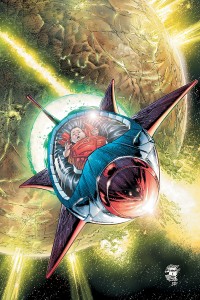
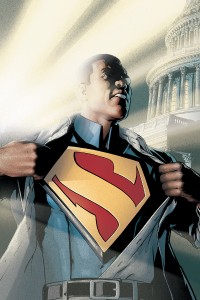
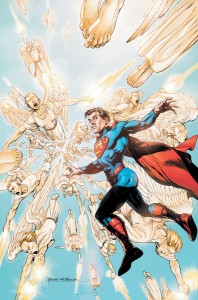
The revelation that the universe was born from Mxyzptlk’s hat, and subsequently that many worlds were destroyed by the multitude, the three dimensional interpretation of the multispear, is an interesting play on gods toying with their creations from above – and of course a parallel of the ability of creators to manipulate their own paper universes. That Kal is a favourite of his 5th dimensional audience for his ability to not be controlled – alongside his father – places him at the centre of the story for reasons beyond him simply being Superman. His angering of a petty god leads to his life being irrevocably damaged, neatly fitting in with the New 52 changes and perhaps hinting at a deeper message.
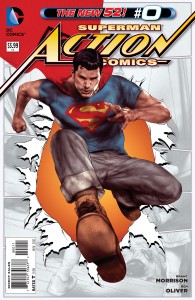
Honestly, I could spend thousands of words picking out all the links and meta-touches here, and still it would do no good – because what you, dear reader, insert in between those gaps and how you read the comic, through the manipulation of time and touch, and what you decide it all comes to… well that’s what makes the comic.
But I defy anyone not to have a little sniffle at the return of Krypto, and for the boys who borrowed Superman’s cape.
Ha-la Kal-El, ha-la-la!
Action Comics #1-18
Writer: Grant Morrison
Pencillers: Rags Morales, Brad Walker, Andy Kubert, Gene Ha, Travel Foreman, Cafu
Inkers: Andrew Hennessy, Mark Propst
Colourist: Brad Anderson, Art Lyon
Cover Artist: Rags Morales, Brad Anderson
Letters: Steve Wands, Patrick Brosseau
Editor: Matt Idelson, Will Moss
Publisher: DC
[Laura Sneddon is a comics journalist and academic, writing for the mainstream UK press with a particular focus on women and feminism in comics. Currently working on a PhD, do not offend her chair leg of truth. Her writing is indexed at comicbookgrrrl.com and procrastinated upon via @thalestral on Twitter]


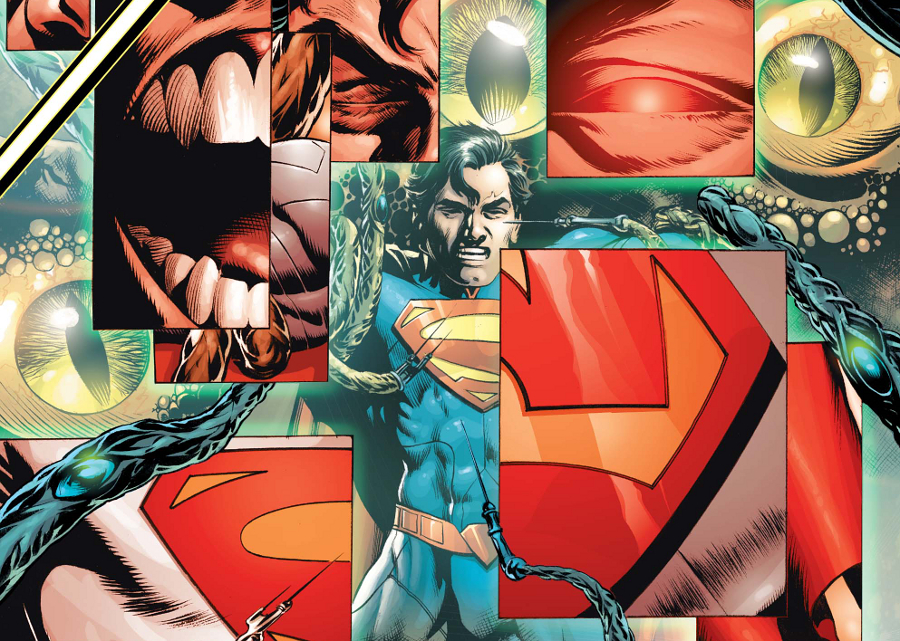



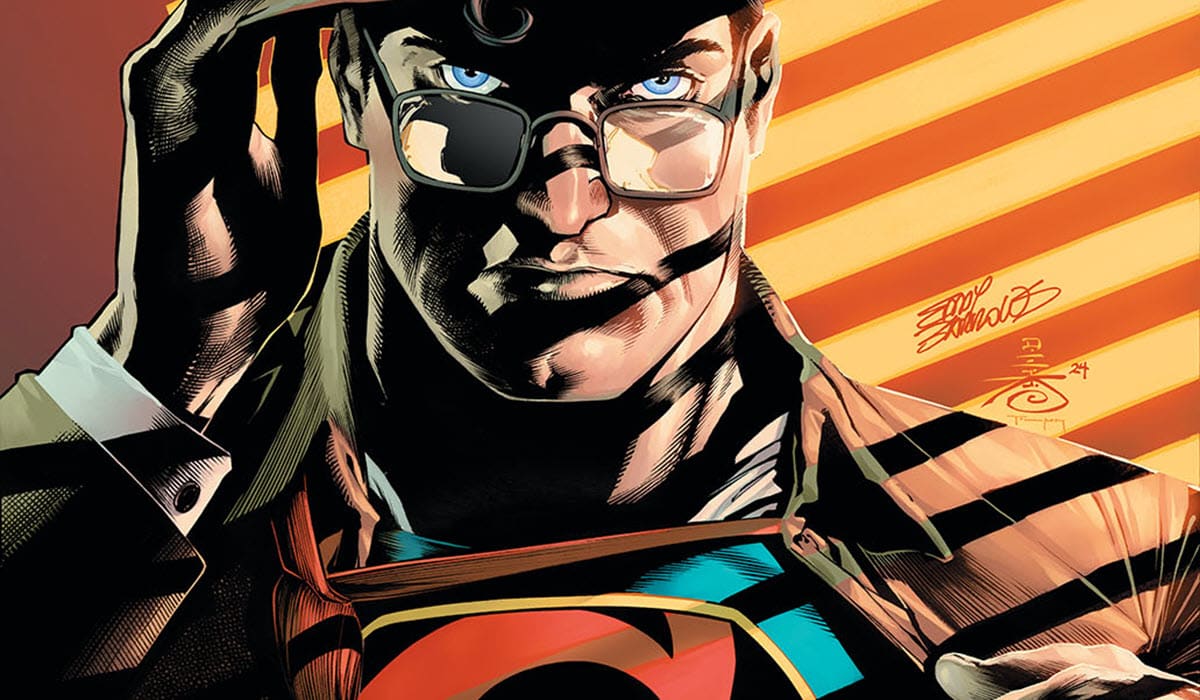




Laura, thanks for this. Morrison is my favorite writer and I haven’t yet had a chance to reread his entire Action run, but this definitely helps me get some of my thoughts in place. Two things in particular jumped out at me reading this:
1) You accurately point out that Morrison’s Action is a tapestry. I wonder if this is Grant’s attempt to write something as intricately constructed as Moore’s Watchmen without the misanthropy? Morrison has often said it’s the form he admires about Watchmen, after all…
2) The idea that Action is a tribute to Golden Age Superman is a really interesting one, especially when paired with All-Star being Morrison embracing the Silver Age. I’m starting to think Grant has worked backwards through the eras of Superman, starting with Modern (when he wrote JLA) – and it looks like most of his superhero work is done for the foreseeable future. Very interesting trajectory for a writer, I think. But this point is just my thinking out loud – sorry it’s so ill-formed. Thanks again for the great piece!
Superman shot in the brain? Earth 23? Fighting the devil?
Reading about superheros sometimes sounds like a hilarious acid trip.
it was crap
DC did itself no favors on this book. The art alone made me drop it.
Eric – regarding your first point, there’s actually quite an interesting difference between this run on Action Comics and the likes of say Watchmen or All-Star Superman. The latter were of course both limited runs with a finite end, whereas Action was very much written on the go – particularly with those artist changes leading to inserted storylines. The fact that it does read as intricately and cleverly as it does is a real credit to Morrison – although the fact that little snippets of the grander plan were in place from the beginning is equally interesting!
Either Morrison likes to leave plots dangling or little mysteries in place and later figure out what they mean, or as he holds the whole pattern in his head he is often writing things that subconsciously work out from a later angle into something greater.
Or, y’know, he’s in the fifth dimension already ;)
Your review is trying to find or point some virtues where does not exist such. The take of Grant Morrison in Action Comics is just bad. You can find good ideas, but very poorly developed in it.
I would agree with many comments here that the run’s single issues, when taken as such, may seem disjointed and fragmented. Morrison’s clipped dialogue and transcendental plotlines aren’t for everyone.
But the *quality* of his writing, the obvious reverence he holds for the character and its mythos, is staggering. (Not to mention his reverence for related source material, from L’il Abner to Scott McCloud.) I was pleased to read this review, which codified a lot of what I had been reflecting on in regards to the run.
Were there some missteps? Sure. I’m still not convinced it was worth throwing Ma and Pa on the pyre, for example. But so much was done so very, very right… Not the least of which was restoring Superman to his pedestal as a thinking fan’s clever, brawny, brawling, dangerous, masculine seeker of justice and a walking piece of Americana iconography.
This is one of the very few New 52 revivals that completely works, soup to nuts. Well done, Morrison. Well done, Fisch. Well done, Rags.
And well done, Sneddon!
I ducked out after nine issues and barely remember what was in them at this point. It was a disappointment after All-Star Superman.
I think the references to the Golden Age Superman the reviewer notes are spot on. Having recently read some of the Superman Chronicle volumes, I was really surprised to see how many story elements from those early tales work their way into this run. It made me really admire a storyline that left me tepid at times. All in all, reading these issues through with those early adventures in mind (and see the nods to them that Morrison provides) truly made this a remarkable run with the character. Not everyone’s cup of tea — obviously. But much better than I think some are willing to allow.
I enjoyed Morrison’s run on Action Comics. I guess I’m in the minority here. I thought it was different from the norm and I found it really entertaining.
I enjoyed the hell out of it. It certainly reads better all at once, though.
I think it’s pretty typical Morrison superhero stuff, with a little Invisibles thrown in. Nowhere near his best work. Later issues are just way too dense with weirdness for my taste.
Honestly? It was worth burning down the entire DC universe to create this Superman.
This run, though uneven, was the most original, important, and spot on superhero story in recent times. This is the Superman that created the genre.
I always compare Morrison to Neil Gaiman. the crazy thing about reading Gaiman is that he comes up with these amazing, bonkers ideas but then has the chops to back it up in a story.
Morrison has even more bonkers ideas, but his story is always coming apart at the seams, so I can see why folks were turned off. But it’s too bad, because this is the best superhero writing out there right now.
Power, originality, and spot on superheroics. I hope everyone was reading it, but it’s more likely they were all reading about Robin getting killed. (Again.)
Morrison failed in a fundamental way on this book. The concept of the New 52 was to reinvigorate these older characters for a new audience, free of baggage and accessible. Morrison’s writing although undoubtly interesting and complex is largely inaccessible for folks who don’t regularly read comics. He is telling a disjointed tapestry full of Superman Easter eggs for the seasoned Superman reader but the elusive new reader is no doubt baffled by these strange and bizarre plot lines. I am glad it’s so exciting and rewarding for the Superman reader but looking at sales it does not look like he has done much to advance the brand. This Morrison Superman arc is really a microcosm of what’s wrong with comics, writers telling stories for a select group of hard core fans that no casual reader would understand or touch.
Robin was killed off BY Grant Morrison!!
I love it when experienced comics readers are concerned about new comics readers and how overwhelmed they must be by history/mythology/story. Sorry but this is part of what makes comics so great. The depth of story and mythology around these characters is both staggering and amazing – I dont think it should ever be thought of as actual baggage!
As a new comic reader, I cut my teeth on Morrison’s RIP run and I loved it. It was challenging and subtle and nuanced. If instead I had only read a Bendis penned Avengers comic – I would most likely not still be a comic reader….
Also I liked this review, thanks for your well constructed thoughts on this run!
A few random thoughts:
Morrisson’s AC needs to be read at least a few times to be fully appreciated. To all the early quitters: Your loss. This story works a lot like Seven Soldiers. Try reading it in a few different orders.
I love the easter eggs and references.I’m sure I’m overlooking many cause I’m relatively new to the world of Superman but that only means that there’s a lot of stuff to like once I know more!
Sholly Fisch backup stories are not that great. Well they fitted properly a lot of the times but can’t say it was really inspired writing.
About the art. The run had some great art: Andy Kubert, Gene Ha are some of the business’ best. Rags Morales did an ok job. It looked kinetic and fitted the young and vibrant nature of a young Superman and also was a good match for a book called Action Comics. I could feel the action. On the downside, Morales art was a bit crude and also not very clear in describing what was happening. Morrisson has had a fair share of mediocre artists to his books. It could be far worse: JLA. Doom Patrol. Invisibles, partly. All these had artists worse or not much better than Morales.
I think Morrisson’s AC is a solid read and for me it’s almost as good as his Batman. I love both the epic scale and longevity of Batman and the tight and compact of AC. Both are epic in their own way.
I just wanted to add my two cents to the chatter here. I was a diehard comic book reader growing up, and then I moved away from the genre in my twenties. With the new 52, I jumped back in. After the first few issues of AC I decided that it would be best to read the whole Morrison run in one go once it finished, as I was forgetting things month to month. Once the final issue did come out, I had a really enjoyable weekend. I loved the art, and I loved this take on Superman. Previously, I found the idea of Superman as a somewhat boring, cliche figure in our contemporary mythos of superhero characters, but I’m totally on board now, and I look forward to other writers, hopefully, taking on some strange, interwoven narrative as Morrison has established. I loved it.
I read the first 8 issues and thought it was decent. Not bad. But then I got into the following issues and I ran into the problem that someone else mentioned above. The New 52 was meant to make things easy and fun to dig into, especially as a new reader. I’m not new, but I’m a little fresher with DC than I was with Marvel. But either way, I got really lost by issue 11 or so. Not lost as in, “I don’t get it” but lost as in “Why am I here?” There seemed to be very little that was keeping me attracted to a character that I’ve always struggled to be interested in. It’s happened before. I liked John’s Brainiac story, and John’s is very hit or miss for me. Regardless, it was tough to keep me interested, month to month, even when I really wanted to be. Here’s to hoping that a full read-through in one sitting will capture my attention better.
I grew up an X-Men fanboy. I zealously collected it and all of the tributary series (New Mutants, Excalibur, X-Factor, X-Force) until Chris Claremont left and Rob Liefeld ruined everything. It was so disappointing that I gave up comics for 20 years.
DC’s “New 52” and Marvel’s “Marvel NOW” succeeded in getting me back to comics. I’ve been working my way through many of the new series, as TPBs borrowed from my local library. I’m trying to find some that I like. I’m on Action Comics right now, and this review has helped to address some of my frustration. Only some, though.
I see what Grant Morrison was trying to do, just as I see how the style was a deliberate throwback/tribute to the Golden Age. I particularly like the contrast between the young, brash, dangerously self-righteous Superman and the more mature Superman that most people know. But ultimately, I have to agree with Jesse’s take above: I, as a new reader, simply don’t enjoy the poor artwork and the disjointed, overly nostalgic storyline. I do not want to continue reading, and in that sense, the run was a failure.
Typo in page paragraph 4. The word should be “writer’s” but the apostrophe is missing. Other than that, good review.
I think it is fair to say that Morrison’s Action Comics run is already forgotten and to the extent it is remembered, it is a reminder of why the new 52 Superman utterly failed to resonate with fans. Ridiculously decompressed, long, confusing, disjointed and devoid of key character development regarding Clark’s parents and supporting cast. Is it any wonder the new 52 Superman is destined to die given his unfocused origins? I think not.
Morrison’s Action Comics will never be forgotten by those who loved it. Believe the hype, read the shit out of it.
I’ve been rereading Morrison’s run and I just stopped by to comment because of the comment above.
Grant Morrison’s Action Comics run may have been forgotten by ”public perception”, it may not be relevant to chronology as we see it, and that’s hardly Morrison’s fault, it’s just something that happens when people don’t pick your narrative threads in an ever continuing story. Still, it’s a different thing to say a run is irrelevant in a business/chronological sense, and a bad story. In many ways, Morrison’s Batman run is already forgotten as well, everything from there is gone except for Damian.
I believe Grant Morrison as a writer is used to make stories that work on their own right, outside chronology. New X-Men works on its own. His Batman as well. Even his JLA. It’s the same with Action Comics.
So it may have been ”forgotten”, in a public sense, but really, I’ll remember it forever. I bet Laura Sneddon will as well. Many will, because it’s an iconic, heartfelt, powerful story. Chronology is just a frame for stories, who cares what it ”important” to it? What matters is the story and Action Comics pulls it off.
Comments are closed.